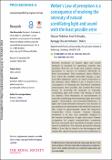Weber’s Law of perception is a consequence of resolving the intensity of natural scintillating light and sound with the least possible error
Author(s)
Pednekar, Shourav; Krishnadas, Arun; Cho, Byunggu; Makris, Nicholas C.
Downloadpednekar-et-al-2023-weber-s-law-of-perception-is-a-consequence-of-resolving-the-intensity-of-natural-scintillating.pdf (1.639Mb)
Publisher with Creative Commons License
Publisher with Creative Commons License
Creative Commons Attribution
Terms of use
Metadata
Show full item recordAbstract
Efficient resolution of natural light and sound intensity is essential for organisms, systems and machines that rely on visual and auditory sensory perception to survive or function effectively in their environment. This resolution obeys Weber’s Law when the smallest resolvable change, a just-noticeable-difference, grows in direct proportion to the stimulus. Here, Weber’s Law is found to be a consequence of attaining the theoretical minimum mean-square error possible, the Cramer–Rao lower bound, in resolving the intensity of naturally scintillating light and sound. The finding is based on statistics from thousands of measurements of naturally scintillating environmental light and sound signals. Remarkably, just-noticeable-differences in light and sound intensity measured over decades of psychophysical experiments with artificial sources are also found to approximately attain the respective Cramer–Rao lower bounds. Human intensity resolution is in this way optimally adapted to the natural scintillation of light and sound. Pattern recognition by simple matched-filter correlation between measured and hypothetical images cancels natural scintillation. For intensity perception obeying Weber’s Law, this is found to be advantageous and statistically optimal because perceived scintillation is independent of the underlying signal pattern. A small visual patch change or acoustic signature truncation is shown to be lost in natural signal-dependent fluctuations if perception with constant intensity resolution is attempted.
Date issued
2023-03Department
Massachusetts Institute of Technology. Department of Mechanical EngineeringJournal
Proceedings of the Royal Society A: Mathematical, Physical and Engineering Sciences
Publisher
The Royal Society
Citation
Pednekar Shourav, Krishnadas Arun, Cho Byunggu and Makris Nicholas C. 2023Weber’s Law of perception is a consequence of resolving the intensity of natural scintillating light and sound with the least possible errorProc. R. Soc. A.4792022062620220626.
ISSN
1364-5021
1471-2946
Keywords
General Physics and Astronomy, General Engineering, General Mathematics